roof Seat Exeo ST 2010 Owner's manual
[x] Cancel search | Manufacturer: SEAT, Model Year: 2010, Model line: Exeo ST, Model: Seat Exeo ST 2010Pages: 325, PDF Size: 9.34 MB
Page 5 of 325
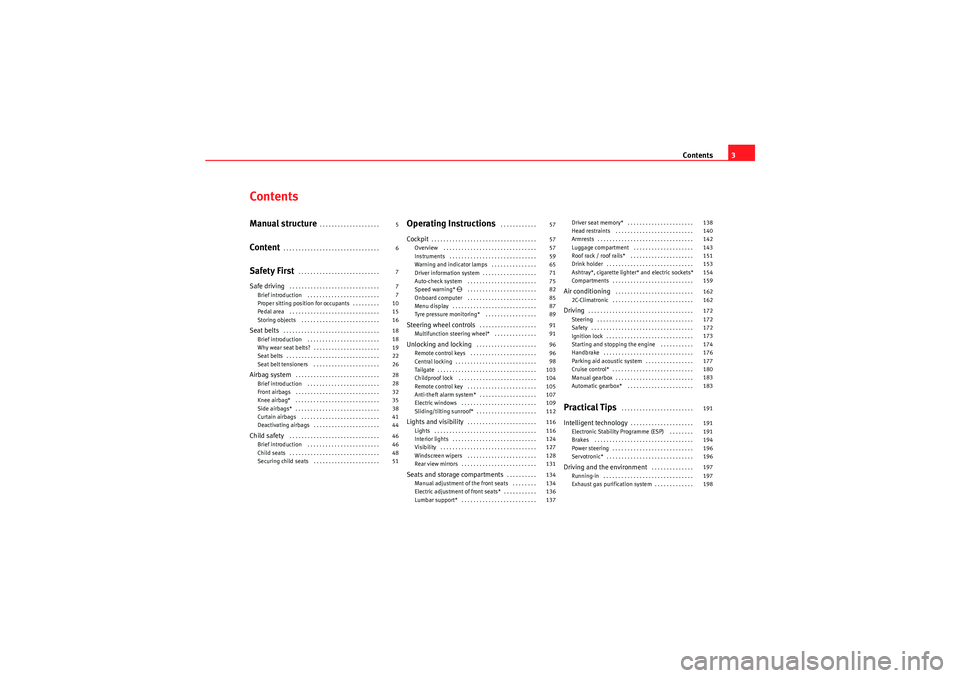
Contents3
ContentsManual structure
. . . . . . . . . . . . . . . . . . . .
Content
. . . . . . . . . . . . . . . . . . . . . . . . . . . . . . . .
Safety First
. . . . . . . . . . . . . . . . . . . . . . . . . . .
Safe driving
. . . . . . . . . . . . . . . . . . . . . . . . . . . . . .
Brief introduction . . . . . . . . . . . . . . . . . . . . . . . .
Proper sitting position for occupants . . . . . . . . .
Pedal area . . . . . . . . . . . . . . . . . . . . . . . . . . . . . .
Storing objects . . . . . . . . . . . . . . . . . . . . . . . . . .
Seat belts
. . . . . . . . . . . . . . . . . . . . . . . . . . . . . . . .
Brief introduction . . . . . . . . . . . . . . . . . . . . . . . .
Why wear seat belts? . . . . . . . . . . . . . . . . . . . . . .
Seat belts . . . . . . . . . . . . . . . . . . . . . . . . . . . . . . .
Seat belt tensioners . . . . . . . . . . . . . . . . . . . . . .
Airbag system
. . . . . . . . . . . . . . . . . . . . . . . . . . . .
Brief introduction . . . . . . . . . . . . . . . . . . . . . . . .
Front airbags . . . . . . . . . . . . . . . . . . . . . . . . . . . .
Knee airbag* . . . . . . . . . . . . . . . . . . . . . . . . . . . .
Side airbags* . . . . . . . . . . . . . . . . . . . . . . . . . . . .
Curtain airbags . . . . . . . . . . . . . . . . . . . . . . . . . .
Deactivating airbags . . . . . . . . . . . . . . . . . . . . . .
Child safety
. . . . . . . . . . . . . . . . . . . . . . . . . . . . . .
Brief introduction . . . . . . . . . . . . . . . . . . . . . . . .
Child seats . . . . . . . . . . . . . . . . . . . . . . . . . . . . . .
Securing child seats . . . . . . . . . . . . . . . . . . . . . .
Operating Instructions
. . . . . . . . . . . .
Cockpit
. . . . . . . . . . . . . . . . . . . . . . . . . . . . . . . . . . .
Overview . . . . . . . . . . . . . . . . . . . . . . . . . . . . . . .
Instruments . . . . . . . . . . . . . . . . . . . . . . . . . . . . .
Warning and indicator lamps . . . . . . . . . . . . . . .
Driver information system . . . . . . . . . . . . . . . . . .
Auto-check system . . . . . . . . . . . . . . . . . . . . . . .
Speed warning* . . . . . . . . . . . . . . . . . . . . . . .
Onboard computer . . . . . . . . . . . . . . . . . . . . . . .
Menu display . . . . . . . . . . . . . . . . . . . . . . . . . . . .
Tyre pressure monitoring* . . . . . . . . . . . . . . . . .
Steering wheel controls
. . . . . . . . . . . . . . . . . . .
Multifunction steering wheel* . . . . . . . . . . . . . .
Unlocking and locking
. . . . . . . . . . . . . . . . . . . .
Remote control keys . . . . . . . . . . . . . . . . . . . . . .
Central locking . . . . . . . . . . . . . . . . . . . . . . . . . . .
Tailgate . . . . . . . . . . . . . . . . . . . . . . . . . . . . . . . . .
Childproof lock . . . . . . . . . . . . . . . . . . . . . . . . . .
Remote control key . . . . . . . . . . . . . . . . . . . . . . .
Anti-theft alarm system* . . . . . . . . . . . . . . . . . . .
Electric windows . . . . . . . . . . . . . . . . . . . . . . . . .
Sliding/tilting sunroof* . . . . . . . . . . . . . . . . . . . .
Lights and visibility
. . . . . . . . . . . . . . . . . . . . . . .
Lights . . . . . . . . . . . . . . . . . . . . . . . . . . . . . . . . . .
Interior lights . . . . . . . . . . . . . . . . . . . . . . . . . . . .
Visibility . . . . . . . . . . . . . . . . . . . . . . . . . . . . . . . .
Windscreen wipers . . . . . . . . . . . . . . . . . . . . . . .
Rear view mirrors . . . . . . . . . . . . . . . . . . . . . . . . .
Seats and storage compartments
. . . . . . . . . .
Manual adjustment of the front seats . . . . . . . .
Electric adjustment of front seats* . . . . . . . . . . .
Lumbar support* . . . . . . . . . . . . . . . . . . . . . . . . . Driver seat memory* . . . . . . . . . . . . . . . . . . . . . .
Head restraints . . . . . . . . . . . . . . . . . . . . . . . . . .
Armrests . . . . . . . . . . . . . . . . . . . . . . . . . . . . . . . .
Luggage compartment . . . . . . . . . . . . . . . . . . . .
Roof rack / roof rails* . . . . . . . . . . . . . . . . . . . . .
Drink holder . . . . . . . . . . . . . . . . . . . . . . . . . . . . .
Ashtray*, cigarette lighter* and electric sockets*
Compartments . . . . . . . . . . . . . . . . . . . . . . . . . . .
Air conditioning
. . . . . . . . . . . . . . . . . . . . . . . . . .
2C-Climatronic . . . . . . . . . . . . . . . . . . . . . . . . . . .
Driving
. . . . . . . . . . . . . . . . . . . . . . . . . . . . . . . . . . .
Steering . . . . . . . . . . . . . . . . . . . . . . . . . . . . . . . .
Safety . . . . . . . . . . . . . . . . . . . . . . . . . . . . . . . . . .
Ignition lock . . . . . . . . . . . . . . . . . . . . . . . . . . . . .
Starting and stopping the engine . . . . . . . . . . .
Handbrake . . . . . . . . . . . . . . . . . . . . . . . . . . . . . .
Parking aid acoustic system . . . . . . . . . . . . . . . .
Cruise control* . . . . . . . . . . . . . . . . . . . . . . . . . . .
Manual gearbox . . . . . . . . . . . . . . . . . . . . . . . . . .
Automatic gearbox* . . . . . . . . . . . . . . . . . . . . . .
Practical Tips
. . . . . . . . . . . . . . . . . . . . . . . .
Intelligent technology
. . . . . . . . . . . . . . . . . . . . .
Electronic Stability Programme (ESP) . . . . . . . .
Brakes . . . . . . . . . . . . . . . . . . . . . . . . . . . . . . . . .
Power steering . . . . . . . . . . . . . . . . . . . . . . . . . . .
Servotronic* . . . . . . . . . . . . . . . . . . . . . . . . . . . . .
Driving and the environment
. . . . . . . . . . . . . .
Running-in . . . . . . . . . . . . . . . . . . . . . . . . . . . . . .
Exhaust gas purification system . . . . . . . . . . . . .
5
6
7
7
7
10
15
16
18
18
19
22
26
28
28
32
35
38
41
44
46
46
48
51 57
57
57
59
65
71
75
82
85
87
89
91
91
96
96
98
103
104
105
107
109
112
116
116
124
127
128
131
134
134
136
137 138
140
142
143
151
153
154
159
162
162
172
172
172
173
174
176
177
180
183
183
191
191
191
194
196
196
197
197
198
ExeoST_EN.book Seite 3 Freitag, 3. September 2010 11:41 11
Page 31 of 325

Airbag system29
Safety First
Operating Instructions
Practical Tips
Technical Specifications
•Always adjust the front seats properly.
The danger of fitting a child seat on the front passenger seat
Rear-facing child seats must never be used on the front
passenger seat when the front passenger airbag is enabled.The front passenger airbag is a serious risk for a child if it is activated. The
front passenger seat is life threatening to a child if he/she is transpor ted in a
rear-facing child seat. Children up to 12 years old should always travel on the
rear seat.
If a rear-facing child seat is secured to the front passenger seat, an inflating
airbag can strike it with such force that it can cause critical or fatal injuries.
Therefore we strongly recommend you to transport children on the rear seats.
That is the safest place for children in the vehicle. Alternatively, the front
passenger airbag can be disabled with a key-operated switch ⇒page 44.
When transporting children, use a child seat appropriate to the age and size
of each child ⇒ page 46.
For those vehicles that do not include a key lock switch to disconnect the
airbag, the vehicle must be taken to a Technical Service.
WARNING
•If a child seat is secured to the front passenger seat, the risk to the child
of sustaining critical or fatal injuries in the event of an accident increases.•Never secure a rear-facing child seat to the front passenger seat if the
front passenger airbag is enabled. The child can suffer critical or fatal inju-
ries if the front passenger airbag is triggered.
•An inflating front passenger airbag can strike the rear-facing child seat
and hurl it with great force against the door, the roof or the backrest.•If, under special circumstances, it is necessary to transport a child in a
rear-facing child seat on the front passenger seat, it is absolutely essential
that you observe the following safety measures:
−Deactivate the front passenger airbag ⇒page 44, “Deactivating
airbags”.
− The child seat must be approved by the child seat manufacturer for
use on a front passenger seat with front or side airbag.
− Follow the installation instructions given by the child seat manufac-
turer and observe the safety instructions ⇒page 46, “Child safety”.
− Before properly installing the child seat, push the front passenger
seat completely backwards so that the greatest possible distance to
the front passenger airbag is ensured.
− Ensure that no objects prevent the front passenger seat from being
pushed completely back.
− The backrest of the front passenger seat must be in an upright
position.
Warning lamp for airbag and seat belt tensioner
�T
This warning lamp monitors the airbag and seat belt
tensioner system.The warning lamp monitors all airbags and seat belt tensioners in the vehicle,
including control units and wiring connections.
WARNING (continued)
WARNING (continued)
ExeoST_EN.book Seite 29 Freitag, 3. September 2010 11:41 11
Page 44 of 325
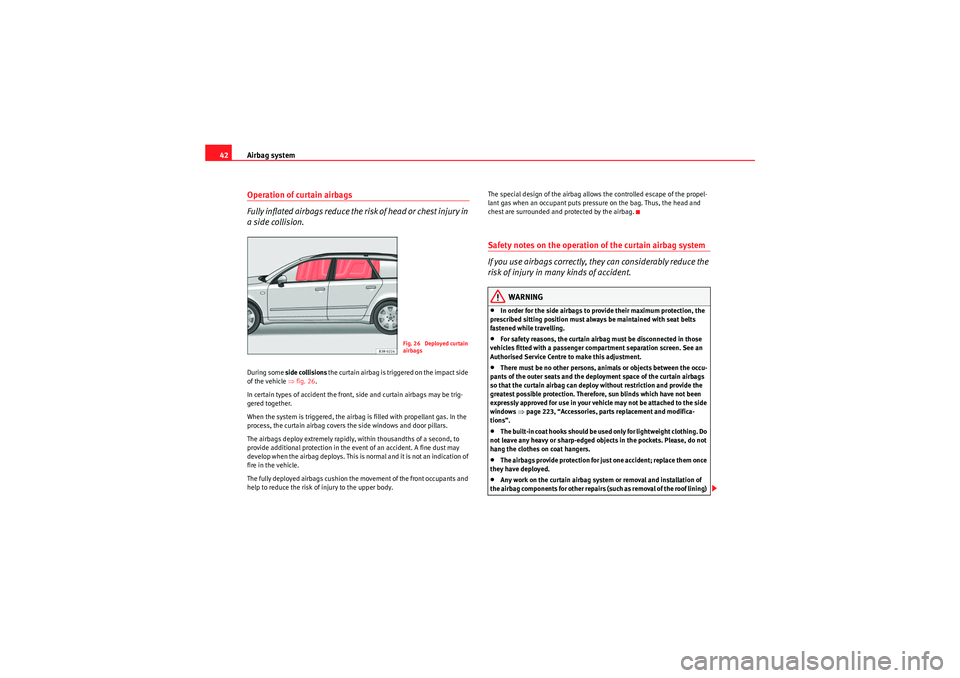
Airbag system
42Operation of curtain airbags
Fully inflated airbags reduce the risk of head or chest injury in
a side collision.During some side collisions the curtain airbag is triggered on the impact side
of the vehicle ⇒fig. 26 .
In certain types of accident the front, side and curtain airbags may be trig-
gered together.
When the system is triggered, the airbag is filled with propellant gas. In the
process, the curtain airbag covers the side windows and door pillars.
The airbags deploy extremely rapidly, within thousandths of a second, to
provide additional protection in the event of an accident. A fine dust may
develop when the airbag deploys. This is normal and it is not an indication of
fire in the vehicle.
The fully deployed airbags cushion the movement of the front occupants and
help to reduce the risk of injury to the upper body. The special design of the airbag allows the controlled escape of the propel-
lant gas when an occupant puts pressure on the bag. Thus, the head and
chest are surrounded and protected by the airbag.
Safety notes on the operation of the curtain airbag system
If you use airbags correctly, they can considerably reduce the
risk of injury in many kinds of accident.
WARNING
•In order for the side airbags to provide their maximum protection, the
prescribed sitting position must always be maintained with seat belts
fastened while travelling.•For safety reasons, the curtain airbag must be disconnected in those
vehicles fitted with a passenger compartment separation screen. See an
Authorised Service Centre to make this adjustment.•There must be no other persons, animals or objects between the occu-
pants of the outer seats and the deployment space of the curtain airbags
so that the curtain airbag can deploy without restriction and provide the
greatest possible protection. Therefore, sun blinds which have not been
expressly approved for use in your vehicle may not be attached to the side
windows ⇒page 223, “Accessories, parts replacement and modifica-
tions”.•The built-in coat hooks should be us ed only for lightweight clothing. Do
not leave any heavy or sharp-edged objects in the pockets. Please, do not
hang the clothes on coat hangers.•The airbags provide protection for just one accident; replace them once
they have deployed.•Any work on the curtain airbag system or removal and installation of
the airbag components for other repairs (such as removal of the roof lining)
Fig. 26 Deployed curtain
airbags
ExeoST_EN.book Seite 42 Freitag, 3. September 2010 11:41 11
Page 100 of 325

Unlocking and locking
98
– Remove the used battery from the cover.
– Insert the new battery. Make sure that the “+” symbol on the battery is facing downwards. The co rrect polarity is indicated on
the cover.
– After inserting the battery, align the cover and key and press the two parts together.
For the sake of the environmentUsed batteries must be disposed of at an appropriate waste facility or
through an authorised service, given that their components can affect the
environment.
Note
•The system must be re-synchronised after each battery replacement to be
able to lock and unlock the vehicle using the remote control ⇒page 107.•The new battery must be of the same type as the original.Electronic immobiliser
The electronic immobiliser is designed to prevent unauthor-
ised persons from starting up the vehicle.There is an electronic chip inside the key which automatically deactivates the
immobiliser when the key is inserted into the ignition lock. The electronic
immobiliser is enabled automatically when the ignition key is removed from
the ignition lock after coming to a stop.
If an uncoded key is used, the message SAFE will appear in the trip recorder
display.
Note
•The engine can only be started using an original SEAT key with the correct
code.•It may not be possible to start the engine with the key if there is another
ignition key from a different make of vehicle on the same key tab.Central lockingDescription
The central locking system enables you to lock and unlock all
the doors, the tailgate and the tank flap together.The central locking system on your vehicle locks and unlocks all the doors
and the tank flap simultaneously. The tailgate is unlocked when the vehicle
is opened. However, the handle must be used to open it. The vehicle can be
locked and unlocked using the remote control ⇒ page 105 or by turning the
key in the lock in the driver door.
The windows can also be centrally opened or closed using the central locking
system ⇒page 111. The sunroof* can be closed but not opened using the
central locking system.
The central locking system is combined with an anti-theft security system. If
the vehicle is locked with the key from the outside, the interior opening levers
stop working, which prevents unauthorised persons from entering the
vehicle.
Should the central locking system fail to work, you can still normally enable
all the locks individually.
ExeoST_EN.book Seite 98 Freitag, 3. September 2010 11:41 11
Page 102 of 325
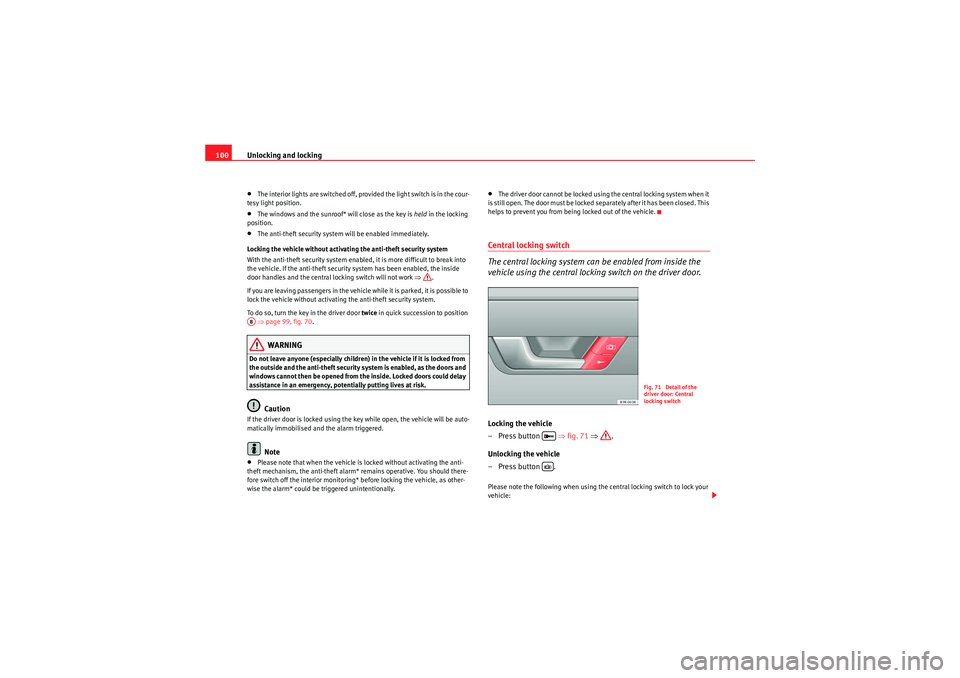
Unlocking and locking
100•The interior lights are switched off, provided the light switch is in the cour-
tesy light position.•The windows and the sunroof* will close as the key is held in the locking
position.•The anti-theft security system will be enabled immediately.
Locking the vehicle without activating the anti-theft security system
With the anti-theft security system enabled, it is more difficult to break into
the vehicle. If the anti-theft security system has been enabled, the inside
door handles and the central locking switch will not work ⇒.
If you are leaving passengers in the vehicle while it is parked, it is possible to
lock the vehicle without activating the anti-theft security system.
To do so, turn the key in the driver door twice in quick succession to position
⇒ page 99, fig. 70.WARNING
Do not leave anyone (especially children) in the vehicle if it is locked from
the outside and the anti-theft security system is enabled, as the doors and
windows cannot then be opened from the inside. Locked doors could delay
assistance in an emergency, potentially putting lives at risk.
Caution
If the driver door is locked using the key while open, the vehicle will be auto-
matically immobilised and the alarm triggered.
Note
•Please note that when the vehicle is locked without activating the anti-
theft mechanism, the anti-theft alarm* remains operative. You should there-
fore switch off the interior monitoring* before locking the vehicle, as other-
wise the alarm* could be triggered unintentionally.
•The driver door cannot be locked using the central locking system when it
is still open. The door must be locked separately after it has been closed. This
helps to prevent you from being locked out of the vehicle.Central locking switch
The central locking system can be enabled from inside the
vehicle using the central locking switch on the driver door.Locking the vehicle
–Press button ⇒fig. 71 ⇒ .
Unlocking the vehicle
–Press button .Please note the following when using the central locking switch to lock your
vehicle:
AB
Fig. 71 Detail of the
driver door: Central
locking switch
ExeoST_EN.book Seite 100 Freitag, 3. September 2010 11:41 11
Page 104 of 325
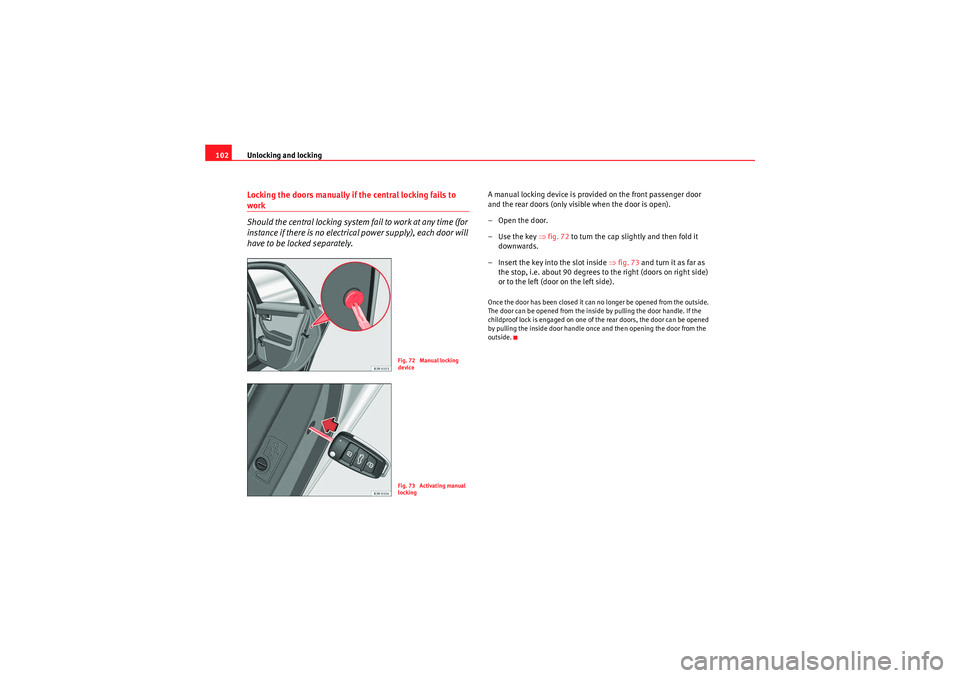
Unlocking and locking
102Locking the doors manually if the central locking fails to work
Should the central locking system fail to work at any time (for
instance if there is no electrical power supply), each door will
have to be locked separately.
A manual locking device is provided on the front passenger door
and the rear doors (only visible when the door is open).
– Open the door.
–Use the key ⇒fig. 72 to turn the cap slightly and then fold it
downwards.
– Insert the key into the slot inside ⇒fig. 73 and turn it as far as
the stop, i.e. about 90 degrees to the right (doors on right side)
or to the left (door on the left side).Once the door has been closed it can no longer be opened from the outside.
The door can be opened from the inside by pulling the door handle. If the
childproof lock is engaged on one of the rear doors, the door can be opened
by pulling the inside door handle once and then opening the door from the
outside.
Fig. 72 Manual locking
deviceFig. 73 Activating manual
locking
ExeoST_EN.book Seite 102 Freitag, 3. September 2010 11:41 11
Page 106 of 325
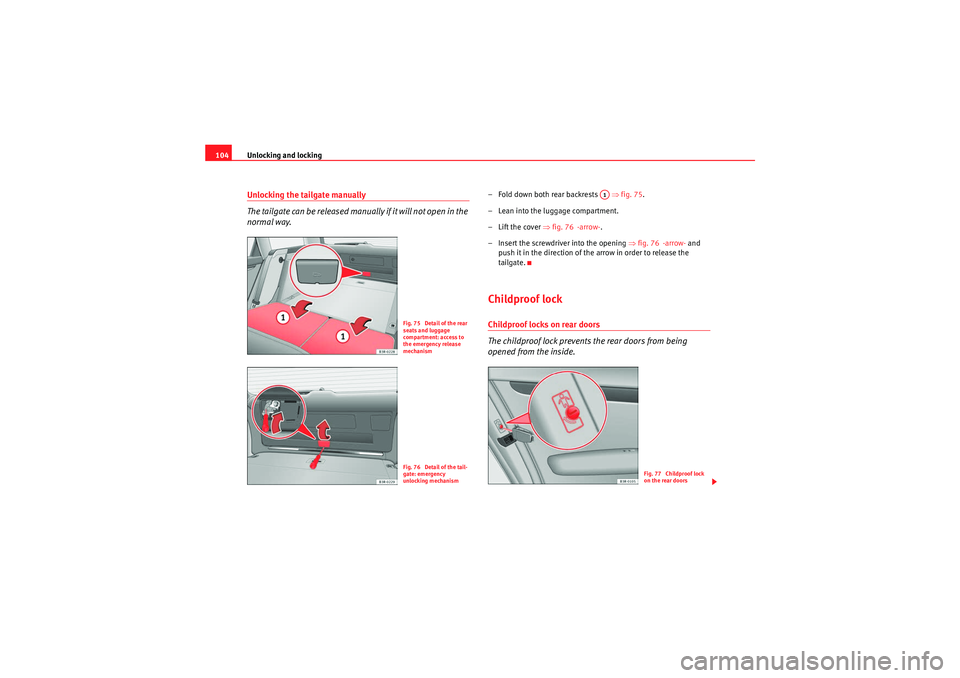
Unlocking and locking
104Unlocking the tailgate manually
The tailgate can be released manually if it will not open in the
normal way.
– Fold down both rear backrests ⇒fig. 75 .
– Lean into the luggage compartment.
– Lift the cover ⇒ fig. 76 -arrow-.
– Insert the screwdriver into the opening ⇒fig. 76 -arrow- and
push it in the direction of th e arrow in order to release the
tailgate.Childproof lockChildproof locks on rear doors
The childproof lock prevents the rear doors from being
opened from the inside.
Fig. 75 Detail of the rear
seats and luggage
compartment: access to
the emergency release
mechanismFig. 76 Detail of the tail-
gate: emergency
unlocking mechanism
A1
Fig. 77 Childproof lock
on the rear doors
ExeoST_EN.book Seite 104 Freitag, 3. September 2010 11:41 11
Page 107 of 325

Unlocking and locking105
Safety First
Operating Instructions
Practical Tips
Technical Specifications
The rear doors are equipped with childproof locks. These can be
operated using the ignition key. The childproof locks are only visible
with the doors open.
Activating the childproof lock
– Turn the key in the direction of the arrow ⇒page 104, fig. 77.
Deactivating the childproof lock
– Turn the key in the opposite direction of the arrow.W he n th e ch ild pro o f l ock is e na ble d , t he insi de d o or ha nd le will no t wo r k an d
the door can only be opened from the outside.Remote control keyDescription
The remote control key will lock and unlock the vehicle
without having to insert the key in the lock.The following functions are available:•Locking and unlocking the vehicle•Unlocking the tailgate
All the turn signals will flash as confirmation when the vehicle is locked or
unlocked. Furthermore, the interior lights will automatically light up when the
vehicle is unlocked and go out when the vehicle is locked, provided that the
switches are in the courtesy light position.
The remote control transmitter and the battery are integrated into the handle
of the key. The receiver is in the interior of the vehicle. The maximum range depends on different circumstances. The range is reduced when the battery
starts to lose power.
The remote control incorporates a foldaway key that can be used to manually
lock or unlock the vehicle, as well as to start the engine.
If the receiver has been repaired or replaced, or if a replacement key is used,
the system will need re-programming by a qualified workshop. Only then will
you be able use the remote control again.
The remote control meets all relevant authorisation requirements and has
b e e n a p p r o v e d b y t h e Fe d e r a l A p p r ov a l s O f f i ce f o r Te le co m m un i ca t i o n s o f t h e
Federal Republic of Germany. All components are marked in accordance with
the current legal requirements. This certification forms the basis for official
approval for use in other countries.
Note
•The remote control is automatically disabled when the ignition is
switched on.•The function of the remote control may be impaired by interference from
other nearby radio signals (e.g. from a mobile phone or TV transmitter) if
these are in the same frequency range.
ExeoST_EN.book Seite 105 Freitag, 3. September 2010 11:41 11
Page 110 of 325
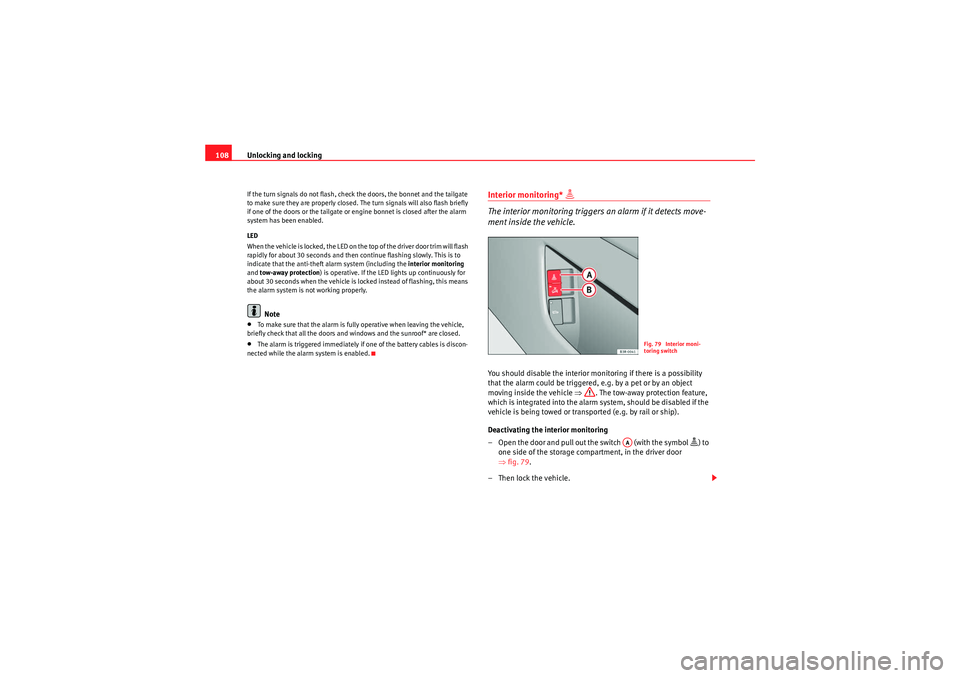
Unlocking and locking
108If the turn signals do not flash, check the doors, the bonnet and the tailgate
to make sure they are properly closed. The turn signals will also flash briefly
if one of the doors or the tailgate or engine bonnet is closed after the alarm
system has been enabled.
LED
When the vehicle is locked, the LED on the top of the driver door trim will flash
rapidly for about 30 seconds and then continue flashing slowly. This is to
indicate that the anti-theft alarm system (including the interior monitoring
and tow-away protection ) is operative. If the LED lights up continuously for
about 30 seconds when the vehicle is locked instead of flashing, this means
the alarm system is not working properly.
Note
•To make sure that the alarm is fully operative when leaving the vehicle,
briefly check that all the doors and windows and the sunroof* are closed.•The alarm is triggered immediately if one of the battery cables is discon-
nected while the alarm system is enabled.
Interior monitoring*
The interior monitoring triggers an alarm if it detects move-
ment inside the vehicle.You should disable the interior monitoring if there is a possibility
that the alarm could be triggered, e.g. by a pet or by an object
moving inside the vehicle ⇒. The tow-away protection feature,
which is integrated into the alarm system, should be disabled if the
vehicle is being towed or transported (e.g. by rail or ship).
Deactivating the interior monitoring
– Open the door and pull out the switch (with the symbol
) to
one side of the storage compartment, in the driver door
⇒ fig. 79 .
– Then lock the vehicle.
Fig. 79 Interior moni-
toring switch
AA
ExeoST_EN.book Seite 108 Freitag, 3. September 2010 11:41 11
Page 114 of 325
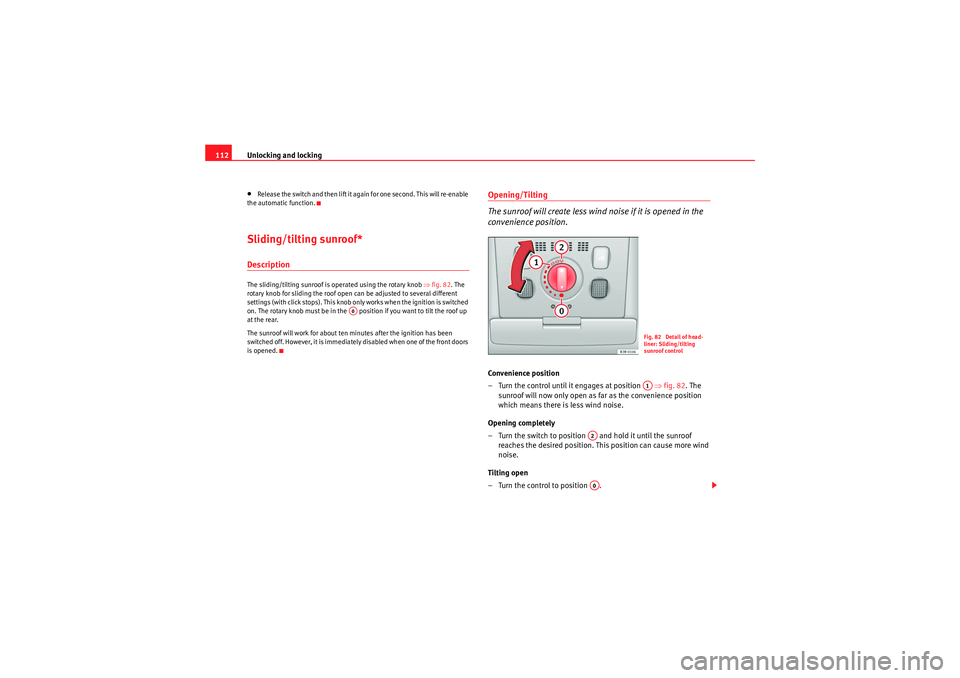
Unlocking and locking
112•Release the switch and then lift it again for one second. This will re-enable
the automatic function.Sliding/tilting sunroof*DescriptionThe sliding/tilting sunroof is op erated using the rotary knob ⇒fig. 82. The
rotary knob for sliding the roof open can be adjusted to several different
settings (with click stops). This knob only works when the ignition is switched
on. The rotary knob must be in the position if you want to tilt the roof up
at the rear.
The sunroof will work for about ten minutes after the ignition has been
switched off. However, it is immediately disabled when one of the front doors
is opened.
Opening/Tilting
The sunroof will create less wind noise if it is opened in the
convenience position.Convenience position
– Turn the control until it engages at position ⇒fig. 82 . The
sunroof will now only open as far as the convenience position
which means there is less wind noise.
Opening completely
– Turn the switch to position and hold it until the sunroof reaches the desired position. This position can cause more wind
noise.
Tilting open
– Turn the control to position .
A0
Fig. 82 Detail of head-
liner: Sliding/tilting
sunroof controlA1
A2A0
ExeoST_EN.book Seite 112 Freitag, 3. September 2010 11:41 11